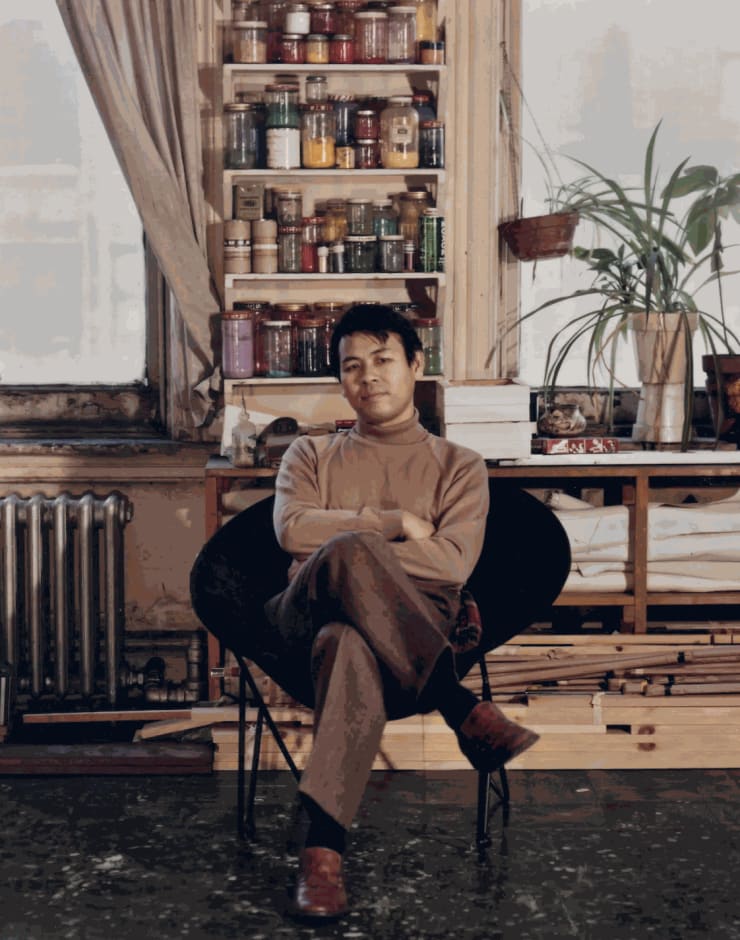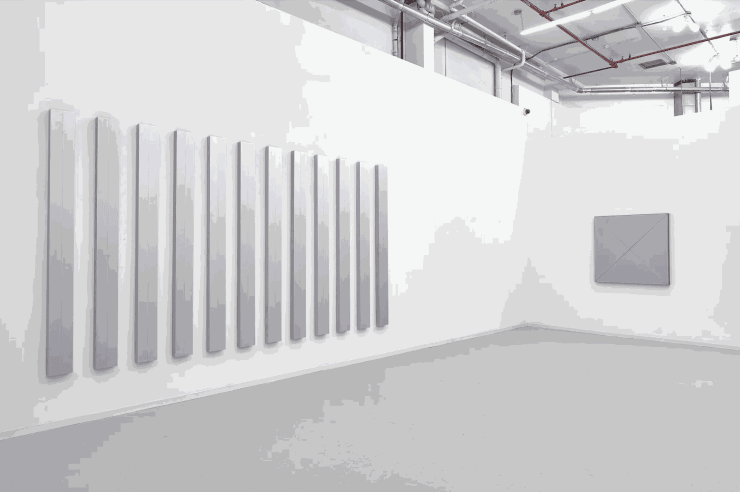Tadaaki Kuwayama, a celebrated painter who forged a distinctively minimal path with cool but vividly colored monochromes, died on Aug. 18 in Manhattan. He was 91.
His wife, the artist Rakuko Naito, said the cause was a cerebral hemorrhage after a fall.
When he arrived in New York City in 1958, Mr. Kuwayama was intent on distancing himself from nihonga, the traditional Japanese painting style in which he’d been trained. But the gestural individualism of Abstract Expressionism, then at the tail end of its dominance, held no appeal for him.
He found instead that he had more in common with friends and acquaintances like Donald Judd and Frank Stella, whose work would later be tagged Minimalist, though he had no use for that label, either. As he put it in a 2012 interview, he wanted to “create works with no trace of touch that can be made by anybody and replicated endlessly.”
Mr. Kuwayama’s first solo show, at Richard Bellamy’s Green Gallery in Manhattan in 1961, included what could be called his signature work, “Untitled: Red and Blue,” a seven-foot-high paper-on-canvas piece divided across the middle into sections of red and blue. In a different painting, that division might evoke a horizon. But two pale bands along the sides of this work, rendered in white pigment overlaid with silver leaf, make it hard to read the line across the middle as anything but a line.
The colors are dense but dry, vibrant but strangely quiet. You can’t sink into them, but they don’t leap out from the surface, either. They have too much texture for the kind of flatness that the critic Clement Greenberg approved of, but not enough to create pattern or depth. They’re nothing but color.
In follow-up shows, starting with a second solo at Green in 1962, Mr. Kuwayama gradually moved from paper to canvas; from dry pigment to acrylic, spray paint and metallic colors; and into flat free-standing pieces reminiscent of the paintings. He developed a vernacular of squares and rectangles divided into halves, quarters or thirds with thin strips of aluminum. Most often every section of a given piece was the same color, but when they weren’t, he avoided both dissonance and obvious harmony by balancing, say, a bright yellow against a white or deep brown.
If some works happened to be beautiful, others were not; for Mr. Kuwayama, that was beside the point. Regarding a 1966 series that included canvases in gray and beige, he said: “I didn’t want to create any distinction between ‘good’ or ‘bad’ colors. I wanted to treat them as equivalent to each other. So I used some horrible colors — all on purpose. I thought of those works as the ‘cheap American apartment series.’”
In 1966, Mr. Kuwayama was included in the influential exhibition “Systemic Painting” at the Guggenheim Museum in New York. But after the 1970s, demand for his work came primarily from Europe, especially Germany. In recent decades he experimented with triangles and began fabricating pieces in aluminum, titanium and Bakelite, including an untitled series of 136 vertical panels in alternating pink and yellow that he produced in 1996 for the Kawamura Memorial DIC Museum of Art in the city of Sakura, Japan.
The panels, hanging at narrow intervals on the sides of a large room, adeptly avoid any figurative allusion. They look almost like stripes, ingots of precious metal, acoustic panels or a hundred other things — but never entirely. In the end, they’re only themselves.
Mr. Kuwayama’s work is held by the Guggenheim, the Buffalo AKG Art Museum and numerous institutions in Japan, including the Nagoya City Art Museum, which gave him a retrospective in 2010, and Germany. At his death, planning was underway for a November show at Marlborough Gallery in Manhattan.
Through career ups and downs and over many decades, Mr. Kuwayama kept producing paintings in the loft where he and Ms. Naito had lived and worked since 1976, in a former stable in the Chelsea neighborhood of Manhattan. Continuity, after all, was part of his concept.
“I’ve never felt the need to sign or date my works,” he said in the same 2012 interview. And as for his earlier paintings, he added: “I can remake them. If anything, it’s more interesting to remake them now. The only thing that changes is the material.”
Tadaaki Kuwayama was born on March 4, 1932, in Nagoya, an industrial port city where his father was a prominent maker of Shinto shrines. Tadaaki was the third youngest of 11 children. His youngest brother, Tadasuke, also became an artist in New York, where he goes by the mononym Tadasky.
Mr. Kuwayama met Ms. Naito in the nihonga program at Tokyo University of the Arts, where she was two years behind him. Although the materials they used — mineral pigments, ink, Japanese paper — had a lifelong impact on their work, both chafed at the rigidity of their instruction. They decided to move to New York after Ms. Naito graduated.
The couple reached California by sea and then traveled across country by Greyhound bus, stopping for a week in Buffalo, Wyo. Before leaving Tokyo, they had met the gallerist and painter Betty Parsons at a dinner with a female companion, and the companion’s daughter lived in Buffalo, in the foothills of the Bighorn Mountains. Mr. Kuwayama and Ms. Naito arrived in New York City on Labor Day in 1958.
Both artists had enrolled in the Art Students League to get student visas, but Mr. Kuwayama, at least, was not impressed with the school.
It “wasn’t a very interesting place to be,” he said. “It was where amateurs and bourgeois wives went, and the teachers were all conservative. So I hardly went to school at all. I would just sign in and go home.”
He did, however, make frequent trips to the nearby Museum of Modern Art, where he learned about developments in art, like Abstract Expressionism, that he’d been unaware of in Japan.
In addition to Ms. Naito, he is survived by two daughters, Sono, an artist, and Maki Kuwayama, an architect; and five grandsons, including Ki Smith, a gallerist, and Sei Smith, an artist.
“When I started my practice,” Mr. Kuwayama said in 2012, “I felt the age of painting was over, and I wanted to make things that had no trace of painterliness in them, things that existed in a different dimension. I wanted to create things that people who believed in painting wouldn’t understand. And I still do.”



